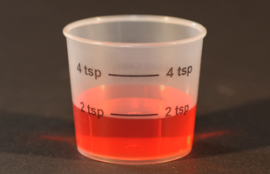According to a 2015 study, every 8 minutes a child under 6 in the United States gets the wrong medication or the wrong dose of their medication. There are a number of ways medication errors can happen with children. Here are some of the most common:
- The child gets the medication twice. It’s easy for this to happen. Maybe Dad gives the child their medication at 4 p.m., but doesn’t mention it to Mom, who gives the child medication again at 5 p.m.
- The child gets the incorrect dose. This can happen because of confusion about units (how many milliliters are in a teaspoon?) or from using imprecise measuring tools, like a spoon from the silverware drawer instead of a medication measuring cup or oral syringe.
- The child gets the wrong medication. This often happens because the caregiver grabs a medication without carefully reading the label to make sure it is the right one.
Everyone makes mistakes, but there are easy steps to take to help prevent medication errors:

A medication measuring cup
- Read the label every time. Make sure you are giving the right medication, and double check the dose you need to give.
- Use a medication measuring cup or syringe. Always use a precise measuring tool, not a kitchen spoon. Most children’s medications these days come with an oral syringe or measuring cup for you to use.
- Keep track of doses. Write down the date and time when you give your child medication, or track it in an app on your smartphone. Make sure all caregivers have access to the information to avoid double dosing.
- Know the poison center number. Keep a poison center magnet on your refrigerator and store 1-800-222-1222 in your phone so that you can get quick, expert help if a mistake happens.




